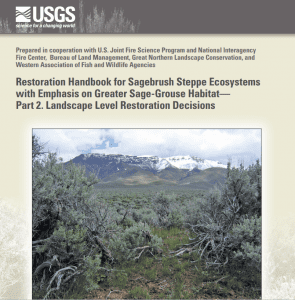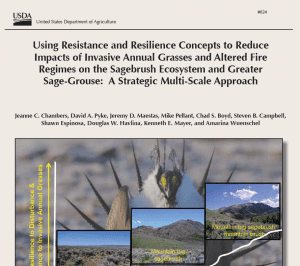Synthesis / Tech Report
View handbook.
This handbook is intended to assist decision makers in determining landscape objectives, to identify and prioritize landscape areas where sites for priority restoration projects might be located, and to aid in ultimately selecting restoration sites guided by criteria used to define the landscape objectives. The landscape restoration decision tool is structured in five sections that should be addressed sequentially. Each section has a primary question or statement followed by related questions and statements to assist the user in addressing the primary question or statement.
View handbook.
This handbook discusses concepts surrounding landscape and restoration ecology of sagebrush ecosystems and greater sage-grouse that habitat managers and restoration practitioners need to know to make informed decisions regarding where and how to restore specific areas, by providing:
- Descriptions of plant dynamics of sagebrush steppe ecosystems and their responses to major disturbances, fire, and defoliation.
- Introductions of the concepts of ecosystem resilience to disturbances and resistance to invasions of annual grasses within sagebrush steppe.
- Introductions to soils and ecological site information will provide insights into the specific plants that can be restored in a location.
- Descriptions of concepts of landscape ecology that aid decisions regarding habitat restoration.
- Overviews of restoration techniques for sage-grouse habitat restoration.
- Descriptions of the critical nature of monitoring for adaptive management of sagebrush steppe restoration at landscape- and project-specific levels.
View report.
This report documents the growth over the past 20 years of the portion of the Forest Service’s budget that is dedicated to fire, and the debilitating impact those rising costs are having on the recreation, restoration, planning, and other activities of the Forest Service.
As more and more of the agency’s resources are spent each year to provide the firefighters, aircraft, and other assets necessary to protect lives, property, and natural resources from catastrophic wildfires, fewer and fewer funds and resources are available to support other agency work—including the very programs and restoration projects that reduce the fire threat.
View the plan.
The Science and Traditional Ecological Knowledge Strategic Plan guides the Great Basin LCC’s science program over a three to five year period (2015-2019). The plan outlines the LCC’s priority topics and how they will be updated, describes the process to determine annual focal topics and activities, and outlines how the LCC will implement, evaluate and adjust the science program.
Priority topics are:
- Adaptation to changes in water availability, temperature, climate variability, and extreme climatic events
- Adaptation to changes in ecosystem structure, processes, function, and interactions
View report.
This final report includes actions to be implemented by Interior’s bureaus to immediately address the threat of rangeland fire and other disturbances to Western sagebrush-steppe landscapes and improve fire and fuels management efforts.
View report.
The initial report includes actions to be implemented by Interior’s bureaus to immediately address the threat of rangeland fire to Western sagebrush-steppe landscapes and improve fire management efforts before the start of the 2015 wildfire season.
View report.
This report outlines national and regional prescribed fire activity, state prescribed fire programs, and identifies impediments limiting the use of prescribed fire. The results include all federal, state, and private prescribed fire acres for forestry, rangeland, and agricultural burning that occurred in 2014.
View report.
This report provides a GIS protocol for identifying strategic locations for fuel breaks to protect remaining large patches of habitat. It was prepared by The Nature Conservancy for the Western Association of Fish and Wildlife Agencies (WAFWA).
Geodatabase that accompanies the report –
File 1 (682MB)
File 2 (84.5MB)
View report.
This report provides a strategic approach for conservation of sagebrush ecosystems and greater sage-grouse that focuses specifically on habitat threats caused by invasive annual grasses and altered fire regimes. It uses information on (1) factors that influence sagebrush ecosystem resilience to disturbance and resistance to invasive annual grasses and (2) distribution, relative abundance, and persistence of sage-grouse populations to develop management strategies at both landscape and site scales.
View report.
This is the final national report of the three-phased National Cohesive Wildland Fire Management Strategy development. The National Strategy includes a set of guidelines intended to provide basic direction when planning activities. Broadly defined to address national challenges, these guidelines can be tailored to meet local and regional needs




